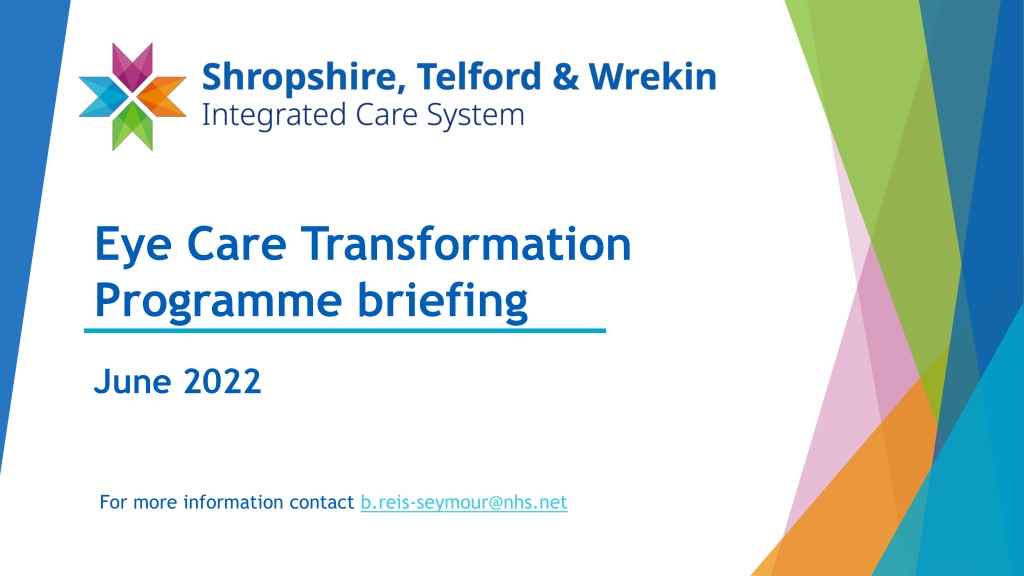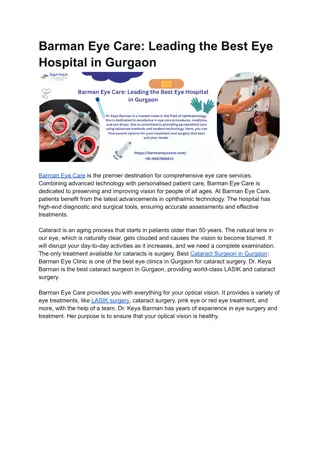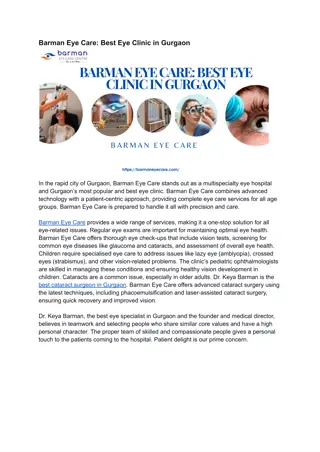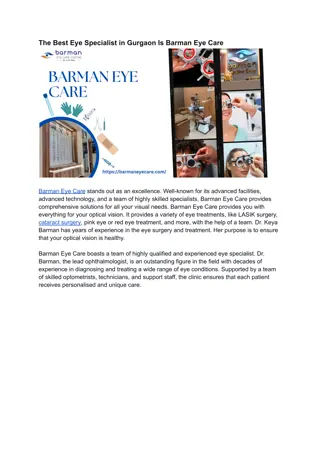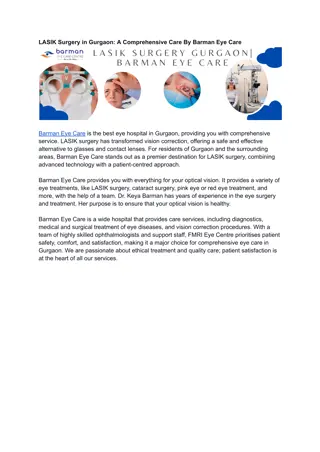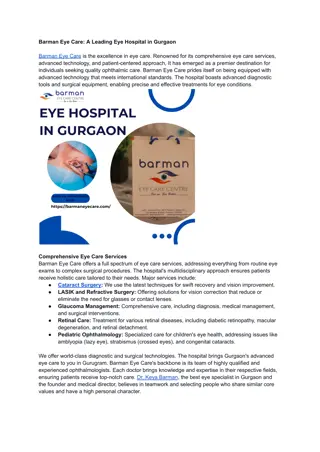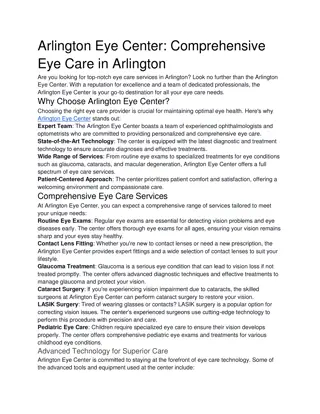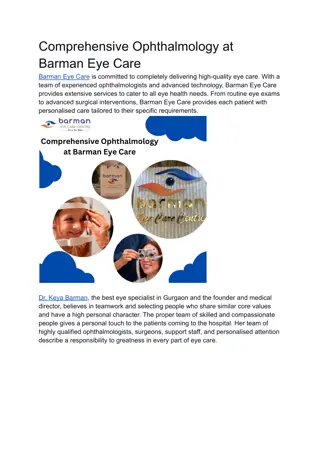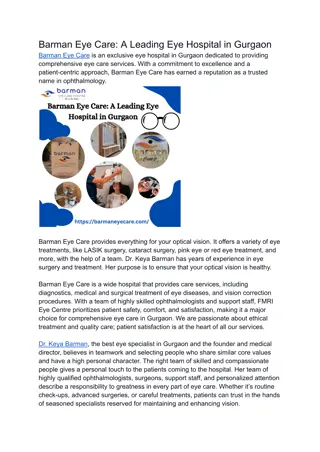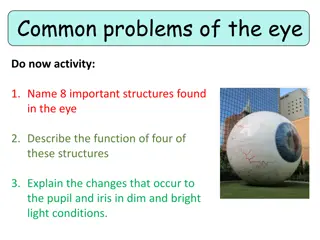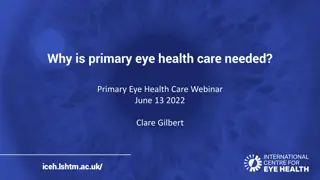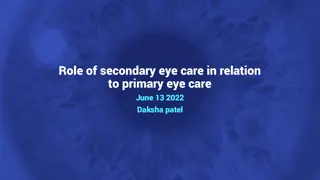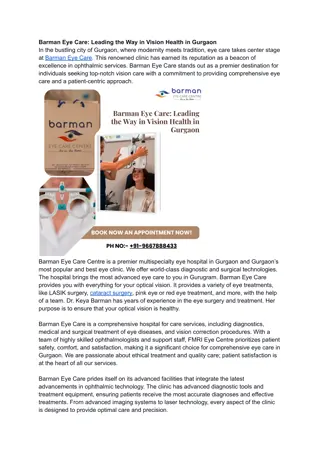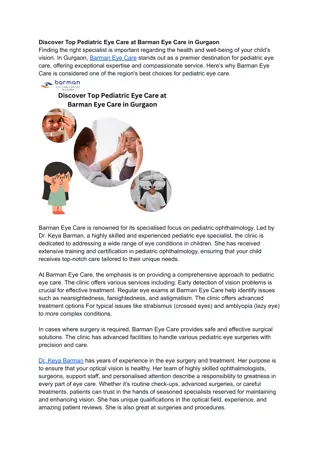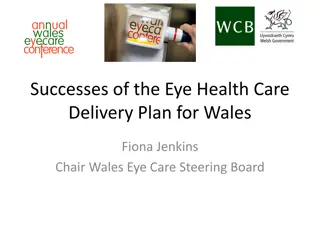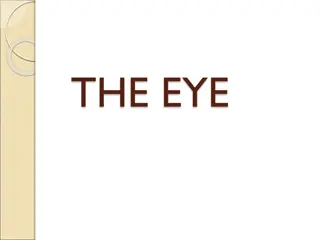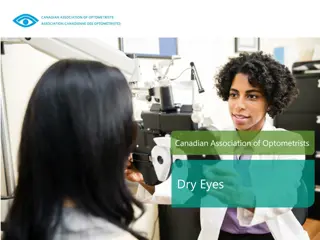Eye Care Transformation Programme Briefing Overview
The Eye Care Transformation Programme in Shropshire, Telford, and Wrekin aims to enhance local eye-care services by identifying key areas for improvement through engagement insights. The program focuses on integrated pathways, referrals processes, and enhancing the overall patient experience. Reasons for change include the need for more efficient services, early detection of eye-related conditions, and leveraging new technologies. Early engagement has gathered valuable feedback, highlighting the importance of good clinical care, stakeholder collaboration, and patient communication.
Download Presentation

Please find below an Image/Link to download the presentation.
The content on the website is provided AS IS for your information and personal use only. It may not be sold, licensed, or shared on other websites without obtaining consent from the author. Download presentation by click this link. If you encounter any issues during the download, it is possible that the publisher has removed the file from their server.
E N D
Presentation Transcript
Eye Care Transformation Programme briefing June 2022 For more information contact b.reis-seymour@nhs.net
Eye Care Transformation Programme - summary Overview Key Data Next Steps Key areas of work that will be included in the eye-care transformation programme are: Identify areas of focus and recommendations based on the engagement insight The health and care system in Shropshire, Telford and Wrekin is planning to transform local eye-care services. Share the report with the design group to inform design and development of future eye-care services Referrals processes The aim is to provide effective eye-care services that are more joined up so that adults and children get the best care possible when and where they need it. Outpatients transformation Integrated pathways across Primary/Community/Secondary eye-care and links with social care s Publish the engagement report and summary to share with those engaged and wider stakeholders including an update on next steps We want to improve the experience of patients and staff working in eye-care services by looking at the way people access care, how they manage their eye conditions, and how the services work together, share information, and provide good patient care. Multi-Speciality pathways Areas of work not included in the programme: Ongoing communication and engagement, including engagement on any new proposals Ophthalmology Surgery Insight gathered through early engagement with the public and clinicians is helping to shape the future model of care. Eye related Cancer Care
Reasons for change To anticipate the increasing need for services To reduce unnecessary face to face outpatient appointments To enhance the early detection and prevention of eye related conditions To provide more joined up services across primary, secondary and community care s To provide more services closer to home, when its needed To make better use of new technologies and developments in eye care To make better use of available data and be able to track people s care
Early Engagement April 2021 262 responses to our survey May 221 July 2021 Outreach sessions within eye care clinics Sept 2021 s Nov 2021 Engagement workshops with the public, NHS providers and independent providers 2022 + Dec 2021 2021 - 22 Community outreach engagement
What we heard: what works well A good standard of care Clinical Stakeholders The clinical care which is provided is of a good standard, staff are engaged and there is a good level of trust between the optometrist and the patient. Patient and Public Patients value the detail they are given about their condition, which gives confidence that they have been correctly diagnosed. Independent Sector Open and honest communication leads to the patient becoming an advocate of the service. Collaborative and Accessible s Clinical Stakeholders Offering patient choice works well, collaborative working with the independent sector and the ability to share images all helps to improve the patient experience and ensure they are seen in a timely manner. Patient and Public Patients tell us that there are direct links between their local optician and the hospital and that when the process works, patients find they are seen quickly and flexibly. They find many of our facilities are suitable for them to access and navigate around. Independent Sector Collaboration between the independent sector and secondary care is important and is assisted by regular meetings with clinicians and operational leads working together, feedback loop between independent sector providers and hospital is key
What we heard: what could be improved Maximise Resources Clinical Stakeholders Make better use of the facilities and skills which are already within the system. Patient and Public Support from sight loss services in the community is sometimes offered too late in a person s care. Better links are needed to mental health, local authority services, low vision clinics and sensory support teams. The independent sector could offer much more, good communication can help to dispel the myths that they only pick the low hanging fruit. Independent Sector Better Communication Clinical Stakeholders Some patients who have undergone treatment in hospital are unsure who to see post-op - better communication to patients pre and post procedures. Services do not feel joined up, Text messages for those with sight loss can be difficult, lots of multiple confusing appointments, not always clear that the independent sector provider is commissioned by the NHS. Improved aftercare information in a variety of formats. All having access to the same patient information, accurate data collection can be a struggle to make the case for change and makes it difficult to re-stratify patients. Strengthening of pathways No direct referral route, too many points where patients can get lost, convoluted and awkward. 2nd eye pathway is very complex. having to attend different settings for different procedures. Repetition of tests and checks, delayed and long waits for appointments can lead to unnecessary falls and other complications, lack of consistency due to changes to services. Patient and Public s Independent Sector Clinical Stakeholders Patient and Public Independent Sector Seamless pathways into and out of secondary care, consistent outcome measures for everyone, ensuring patients do not need other procedures prior to coming to us, easier referral routes, sometimes don t not feel an equal partner within the pathway. Minor Eye Conditions Service (MECS) Clinical Stakeholders A smoother pathway between primary and secondary care, better administration - patients should not have to contact numerous practices to get an appointment. Capacity issues and tariff can make it difficult for primary care optometry. Patient and Public Clarity is needed on the provision of emergency eye care (MECS, urgent eye clinic in Telford, weekends and bank holidays, ease of access, clear signposting and better informed), optometrist capacity for MECS appointments
What we heard: recommendations Care closer to home / Embracing Technology Clinical Stakeholders Capturing diagnostics in the community, virtual reviews. Allow procedures to be carried out in any location by anyone with the appropriate skills. Digital and Advice and Guidance underutilised - bring people together through multidisciplinary learning. Patient and Public Patients would like greater access to clinical provision in the more remote areas of the county, with greater provision of services, and the suggestion of a roaming eye care clinic bus. s Independent Sector Providers Work through the patient pathway and then decide who provides which services, the front end needs to be standardised allowing optometrists to undertake appropriate tests. patients don t want to go to hospital or back into hospital for an eye procedure or appointment that can be done in their community. Holistic Approach Clinical Stakeholders Need a holistic approach to the patient - treat the whole person. Patient and Public Needs to be about the whole person holistic, not just a case or a condition. Access to practice advice, guidance and support during anxious times, easy to read leaflets, create a place where people can try and test different aids prior to purchase, At the moment people tend to get the clinical care and then they are referred it should happen in parallel. Independent Sector Providers Ensure that patients have access to support information.
Next steps Identify areas of focus and recommendations based on the insight captured from the engagement activities Share the insight with the design group to inform design and development of future eye-care services Publish the engagement report to share with those engaged and wider stakeholders including an update on next steps Ongoing communication and engagement, including engagement on any new proposals s
Further information To read our public engagement report, please go to https://www.shropshiretelfordandwrekinccg.nhs.uk/get- involved/current-conversations/ s
